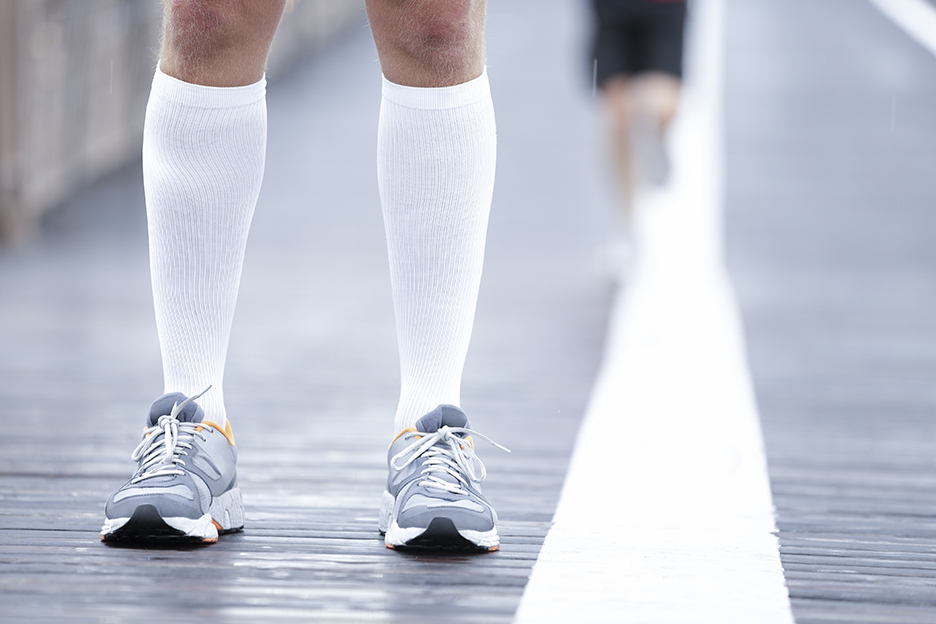Are you familiar with compression stockings? More than ordinary stockings, they provide comfort for tired legs and can help treat a number of...

Compression stockings: what do they do?
Compression stockings, also called support hose or pressure stockings, come in several forms and are used in a variety of situations. They can make a huge difference in terms of your health, your quality of life, and the appearance of your legs.
Compression stockings enhance the work of the veins by placing pressure on them to help bring the blood back toward the heart. The pressure exerted on the legs is constant. The compression is at its maximum at the ankle and gradually lessens toward the top of the leg.
Compression stockings: why and for whom?
A number of people may benefit from compression stockings. They are often recommended for people suffering from venous insufficiency. This is a disease characterized by a dysfunctional venous system. The vein walls are affected, making it harder for the blood to return to the heart. Wearing compression stockings can therefore help improve the blood circulation and, as a result, relieve the symptoms and prevent the consequences of venous insufficiency. These might include:
- feeling of heavy legs
- painful calves
- swollen legs
- nocturnal cramps
- skin ulcers
- varicose veins in the legs
- forming of blood clots
Pregnant women may also suffer from poor blood circulation and benefit from wearing compression stockings. The same is true of people who work long hours on their feet and people taking the plane. For some people, however, compression stockings are not recommended. It is advisable to speak to your doctor or pharmacist before purchasing them.
Types of compression stockings
There are all kinds of compression stockings: socks or knee-highs, thigh-length stockings, and tights or panty hose. They come in different colours and a variety of materials. You can buy pre-made stockings off your pharmacy shelf, or made-to-measure stockings. Whatever the type of stocking, it is important to follow the manufacturer’s recommendations when choosing the size or taking measurements.
The amount of pressure exerted by the stockings can vary, and the choice of the degree of compression will depend on the reason for their use. The level of pressure is expressed in mmHg. For example, 15-20 mmHg stockings will exert less pressure than 30-40 mmHg stockings. Not all levels of compression are available in pharmacies. Stockings with lower compression levels can be found directly on pharmacy shelves, while those with higher compression levels require a doctor’s prescription (these can, in some cases, be ordered through the pharmacy upon receipt of your prescription). It is important to choose the right level of compression. Do not hesitate to ask for help from your physician or pharmacist, who will know how to guide you.
Tips and tricks for maximum comfort
For maximum effectiveness, compression stockings should be put on in the morning even before getting out of bed. They are not ordinary stockings and are not put on the same way. Here are a few tips to help with putting on compression stockings:
- Wear latex gloves to avoid damaging them.
- Put your hand into the stocking and grab the heel.
- Turn the stocking inside out up to the heel.
- Put your foot in and slide the stocking on up to the heel, without pulling.
- Slide the stocking up to the ankle and then up to the knee or thigh, according to the type of stocking.
- Pull on the toe to free your toes.
Several accessories are available to help you put them on more easily; ask your pharmacist.
Just as they are put on differently, compression stockings require different care than ordinary stockings. They cannot be put in the washing machine or dryer. They must be washed by hand, in lukewarm or cold water, with gentle soap. They must be hung up to dry and handled very carefully to avoid being damaged. For this reason, they cannot be wrung out or treated with bleach. Compression stockings should be replaced every six months if you wear them every day.
More than ordinary stockings, compression stockings can solve many problems. They are available in many styles, to suit all tastes. For greater comfort and healthy legs, try compression stockings. You will wonder what you did without them!
